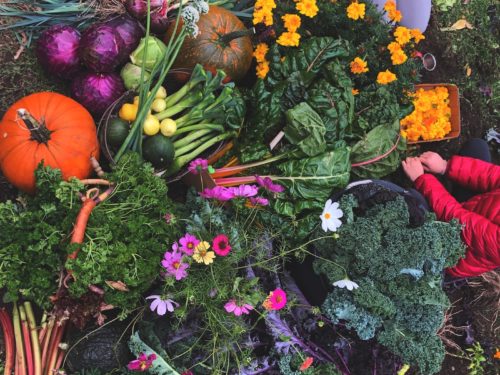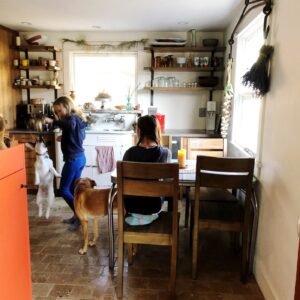I’ve long wanted to make yogurt. Sometimes folding a new something into my life — no matter it’s ease and efficiency — is like trying to recite the alphabet backwards. I can do it but it requires rewiring my synapses and wrinkling my forehead until it snaps into habit. With yogurt-making I had to talk about it for a few years before shoehorning it into my weekly rhythm.
And now that I can wave my homespun probiotic flag, I get to be one of those people who says it’s so easy and affordable! Because it really is both of those things. Also, it’s fun, nutritious and very tasty. And, holy smokes, the waste we are saving! The towers of white plastic tubs are no longer in our reuse or recycle piles. What a relief.
A simple google search will yield a billion DIY yogurt posts. Basically, there are many different ways to do this:
- Heat milk to about 175 degrees fahrenheit.
- Cool milk to about 115 degrees.
- Stir a bit of yogurt into the milk.
- Keep it warm (95-110 degrees) for six hours or overnight.
- Voila, yogurt.
I tried using the crockpot method but found it to be too runny so I switched to the stovetop which I can more easily control. It was better but I still wanted it thicker. After several tweaks, here’s my method of damn perfect yogurt.
You will need:
a big pot
food thermometer
wood spoon
1/2 gallon of whole milk
1/2 cup plain yogurt with live cultures (buy it for your first batch; then use your yogurt for subsequent batches)
4 pint-size canning jars with lids and rings (widemouth is best)
bath towel
cheesecloth (optional)
I make 1/2 gallon or one gallon of yogurt per week. If you make a gallon, double your jars or use 4 quart jars instead. Yogurt will keep for a while in the fridge so don’t be afraid to make a batch and enjoy it over the course of three or so weeks. We love it plain and use it instead of sour cream, and in cooking and baking. We also add to it, after it’s made: maple syrup, honey or a spoonful of jam. I pack yogurt nearly every school day for Margot and feel great about the healthy protein punch she gets during her action-packed day.
1.
Pour milk into pot and turn on medium-high. Stir regularly to bring temperature up to 175 degrees.
2.
Turn heat off and allow to cool to 115-120 degrees. Either let it sit or cool it in an ice water bath. I just let mine sit. It doesn’t take long.
3.
Turn oven on low for three minutes. Add one tablespoon or so of yogurt to each jar. Pour milk into jars. Apply lids and rings. Shake the jar once or twice to just combine yogurt and milk. And then don’t shake anymore.
4.
Turn oven off. Turn oven light on. The oven light will create all the warmth you need! Place jars in oven and wrap them in a towel.
5.
Wait. Six hours later (or over night): Yogurt! Put it in the fridge and it will firm up even more. Stop here if you’re happy.
Or, make it thicker.
6.
After yogurt has cooled, remove lids. Give yogurt a little stir to loosen the whey. Add two layers of cheese cloth and screw on ring. Place jar upside down for an hour or so. I use my over-the-sink strainer but many things would work like cooling rack over pan. I find that if I move the jar every so often, it drains faster. You can easily reuse the cheesecloth: just rinse and drape over sink to air dry.

Yogurt, before drained. Give it a little stir.



And, the facts:
* Previously, we purchased 1/2 gallon (64 ounces) of Nancy’s Whole Milk Yogurt per week at $9.19.
Annual cost: $477.88.
* Now, we purchase one gallon of local, hormone-free whole milk (Kalispell Kreamery) for $4.69. So that’s $2.35 per 1/2 gallon. Annual cost: $122.20.
TOTAL ANNUAL SAVINGS: $355.68!
And, an annual savings of 52 plastic tubs!
Will you give it a go? I can say with confidence that if you love yogurt, you’ll love everything about making it.























